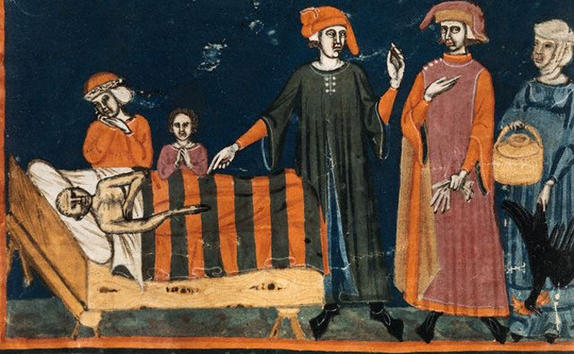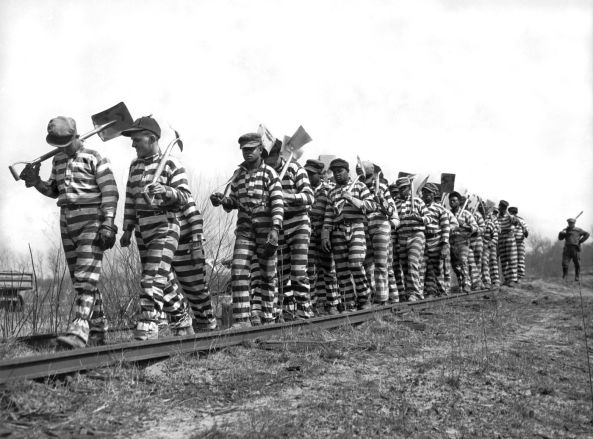 In 1310, in French town of Rouen, one hapless shoemaker was sentenced to death for having been caught wearing a striped garment. This unusual case shows how the striped clothes were treated in the Middle Ages.
In 1310, in French town of Rouen, one hapless shoemaker was sentenced to death for having been caught wearing a striped garment. This unusual case shows how the striped clothes were treated in the Middle Ages.
Michel Pastoureau, one of the best specialists in medieval symbolism, wrote a lively study of stripes, The Devil’s Cloth: A History of Stripes and Striped Fabric, a unique and engaging perspective on the evolution of fashion, taste, and visual codes in Western culture.
The Devil’s Cloth begins with a medieval scandal. When the first Carmelites arrived in France from the Holy Land, the religious order required its members to wear striped habits, prompting turmoil and denunciations in the West that lasted fifty years until the order was forced to accept a quiet, solid color.
The medieval eye found any surface in which a background could not be distinguished from a foreground disturbing. Thus, striped clothing was relegated to those on the margins or outside the social order—jugglers and prostitutes, for example—and in medieval paintings the devil himself is often depicted wearing stripes. The West has long continued to dress its slaves and servants, its crewmen and convicts in stripes. (Columbia University Press.)
Carmelites were, at worst, stoned and, at best, met with whistles and all sorts of intimidation. The conflict came to the attention of Pope Alexander IV, who forbade wearing of striped robes by the Supreme Decree. The stubborn Carmelites did not abide by the papal prohibition. The Vatican persisted and the final bull of Pope Boniface VIII forbade wearing strips by all Catholic monastic orders in the world, without exception .

GERMANY – CIRCA 2002: Scene of court life with musicians playing viola, dulcimer, fife, drum and bagpipes, miniature from Manesse Code, manuscript, 1304, Germany. (Photo by DeAgostini/Getty Images)
In the preface to his book, Pastoureau writes that preserved since XII-XIII century, abundant documentation shows that striped clothing was considered shameful, degrading and downright diabolical. Striped attire was worn by executioners and prostitutes. In medieval Europe striped suits were worn by all sorts of outcasts — circus performers, jesters, lepers, cripples, heretics and illegitimate children.
 To this day, there is no consensus about the origin of stripes’ bad reputation. Pastoureau suggests that it came from the free interpretation of biblical quote Do not put on two tunics (Mark 6:9.) Another hypothesis, secular one, is more “practical”: striped clothing conceal the silhouette, and this alone could be regarded as an attempt of camouflage. However, neither the first nor the second hypothesis can explain the reasons for the medieval Europeans’ hateful attitude toward striped garments.
To this day, there is no consensus about the origin of stripes’ bad reputation. Pastoureau suggests that it came from the free interpretation of biblical quote Do not put on two tunics (Mark 6:9.) Another hypothesis, secular one, is more “practical”: striped clothing conceal the silhouette, and this alone could be regarded as an attempt of camouflage. However, neither the first nor the second hypothesis can explain the reasons for the medieval Europeans’ hateful attitude toward striped garments. Diabolical nature of strips extends to the striped animals as well. Not only black, but striped cats, tigers, snakes and hyenas were considered to have diabolical traits. Although in the Middle Ages only very few Europeans knew of the existence of zebras, Catholic naturalists ranked zebras as “devils of animals.” Unsuspecting zebras were relinquished to this category until the age of Reformation when the new generation of zoologists dispelled this belief.
Diabolical nature of strips extends to the striped animals as well. Not only black, but striped cats, tigers, snakes and hyenas were considered to have diabolical traits. Although in the Middle Ages only very few Europeans knew of the existence of zebras, Catholic naturalists ranked zebras as “devils of animals.” Unsuspecting zebras were relinquished to this category until the age of Reformation when the new generation of zoologists dispelled this belief.
 The strips shed its diabolical designation at the end of the XVIII century. Revolution occurred not only in France and the New World, but also in the minds of ordinary people. Stripes were no longer seen as taboo. A fashion for striped fabric, from clothing to furniture upholstery and walls, took off with vengeance.
The strips shed its diabolical designation at the end of the XVIII century. Revolution occurred not only in France and the New World, but also in the minds of ordinary people. Stripes were no longer seen as taboo. A fashion for striped fabric, from clothing to furniture upholstery and walls, took off with vengeance.
 However, in 19th century, coming a long way from the Middle Ages, the fear of stripes in society was embodied in the striped prison uniforms. Around this time, the black-and-white stripes familiar from old movies came into vogue, marking the men in a way that would remain embedded in public memory.
However, in 19th century, coming a long way from the Middle Ages, the fear of stripes in society was embodied in the striped prison uniforms. Around this time, the black-and-white stripes familiar from old movies came into vogue, marking the men in a way that would remain embedded in public memory.  Slowly, as time went on, prisons began to eliminate the stripes for more neutral colors and the familiar worker-like jumpsuits. New York switched to grey in 1904 because, according to an article in Slate, the stripes were “a badge of disgrace.” Many states kept the stripes longer; North Carolina kept them until 1958.
Slowly, as time went on, prisons began to eliminate the stripes for more neutral colors and the familiar worker-like jumpsuits. New York switched to grey in 1904 because, according to an article in Slate, the stripes were “a badge of disgrace.” Many states kept the stripes longer; North Carolina kept them until 1958.

